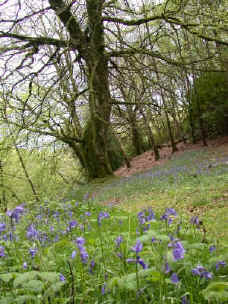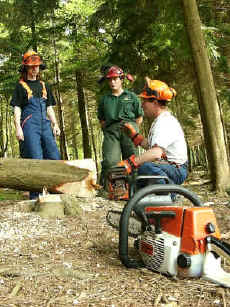In
broadleaf woodlands in Britain, high light levels reach the ground for several months in
the period between the loss of the tree leaves in the autumn and the regrowth of the leaf
canopy in the spring. This means that in warmer periods of the autumn and spring, species
in the lower woodland layers have the opportunity to capitalize on the high light levels
temporarily available. This can provide the energy essential for successful flowering and
seed production.
.

|
Species which take advantage of this include Bluebells and Wood Anemones.
Bluebells flower in the spring, using reserves stored up in underground bulbs the previous
year. Once flowering is completed, they will replace the reserves, utilizing the higher
light levels available before the leaf canopy regrows and once more blocks out the light.
By high summer, all that remains to advertise their presence are the dead leaves and spent
seed heads. This illustrates an important point
- the layers within a woodland will often alter according to season. Thus, the field layer
in a woodland may more or less disappear over the winter months, as all the vegetative
parts of the grasses, herbs and ferns die back. New growth burgeons as warmer weather
approaches, giving rise to a succession of different species with varying degrees of shade
tolerance. These may range from Lesser Celandine, Dog's Mercury and Wood Anemones in early
Spring, to Bluebells and Ground Ivy in May. Still later on, such plants as more
shade-tolerant, delicate Enchanter's Nightshade and Yellow Pimpernel may appear.
|
In contrast to broadleaf woodlands, there is no
period when the trees lose all their needles in a coniferous woodland. This is because the
trees are mostly evergreen (with the odd exception, such as Larch). As a result, there is
no seasonal period when unobstructed light reaches the woodland floor. The plant species
which require a relatively high light intensity to produce flowers, will therefore be
excluded from darker coniferous woodlands because of an inability to reproduce
successfully. This means that the lower field and ground layers may be substantially less
diverse than a comparable broadleaf woodland.
 |
Coniferous woodlands are also generally
purpose-planted for timber production. Competing plants are therefore removed or
discouraged from growing. Dense, relatively young stands of conifers will also have very
low light conditions underneath. This prevents the development of field and ground layers.
Later on, the crop will be thinned. This encourages greater
growth from the remaining conifers. After thinning and as the crop grows taller, enough
light may reach the ground for these layers to develop. The number and variety of other
plants in a coniferous woodland therefore depends to a great degree on the age and density
of the dominant tree crop. A mature coniferous woodland may actually have a better
development of field and ground layers than a heavily shaded broadleaf woodland such as
Beech. |
The underlying structure in a coniferous woodland
will also depend on the type of conifer making up the woodland. For example, more light
reaches the ground underneath larches, which tend to have a spreading loose canopy, which
is also deciduous. |


